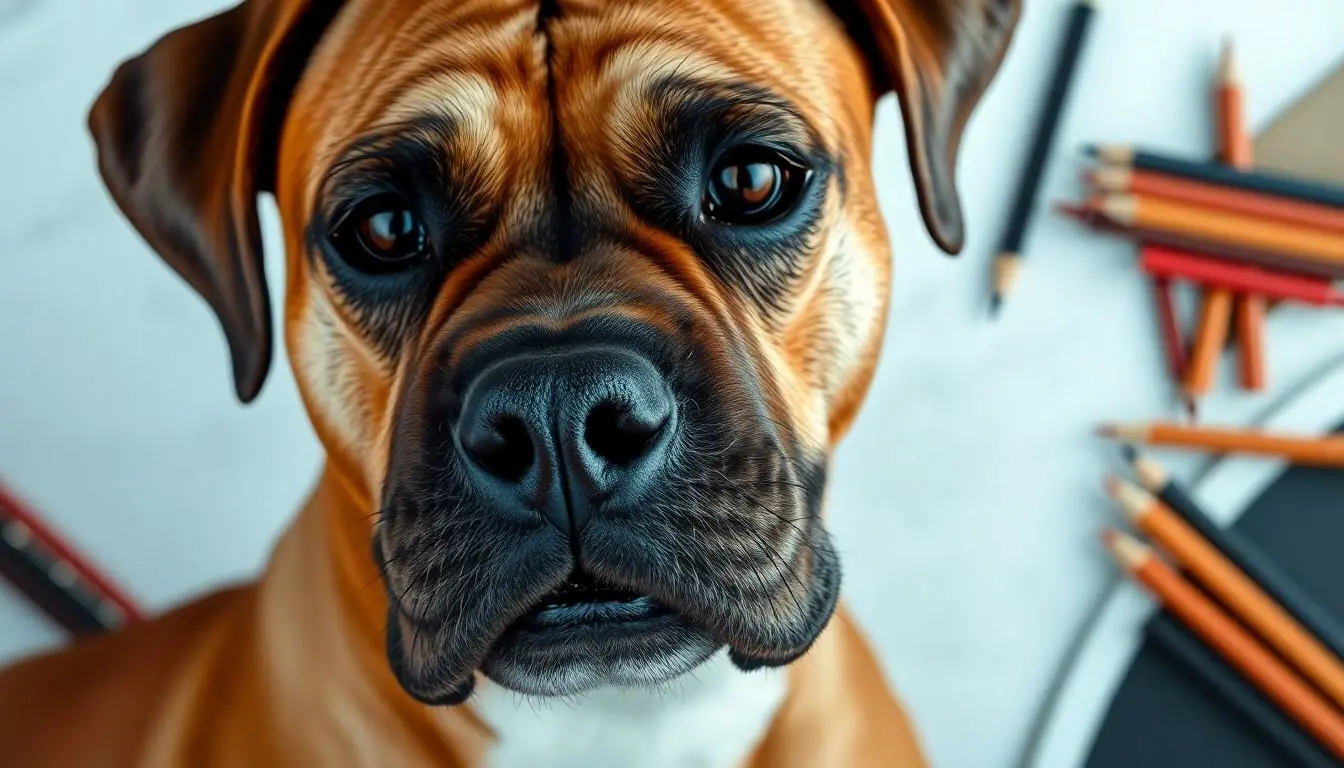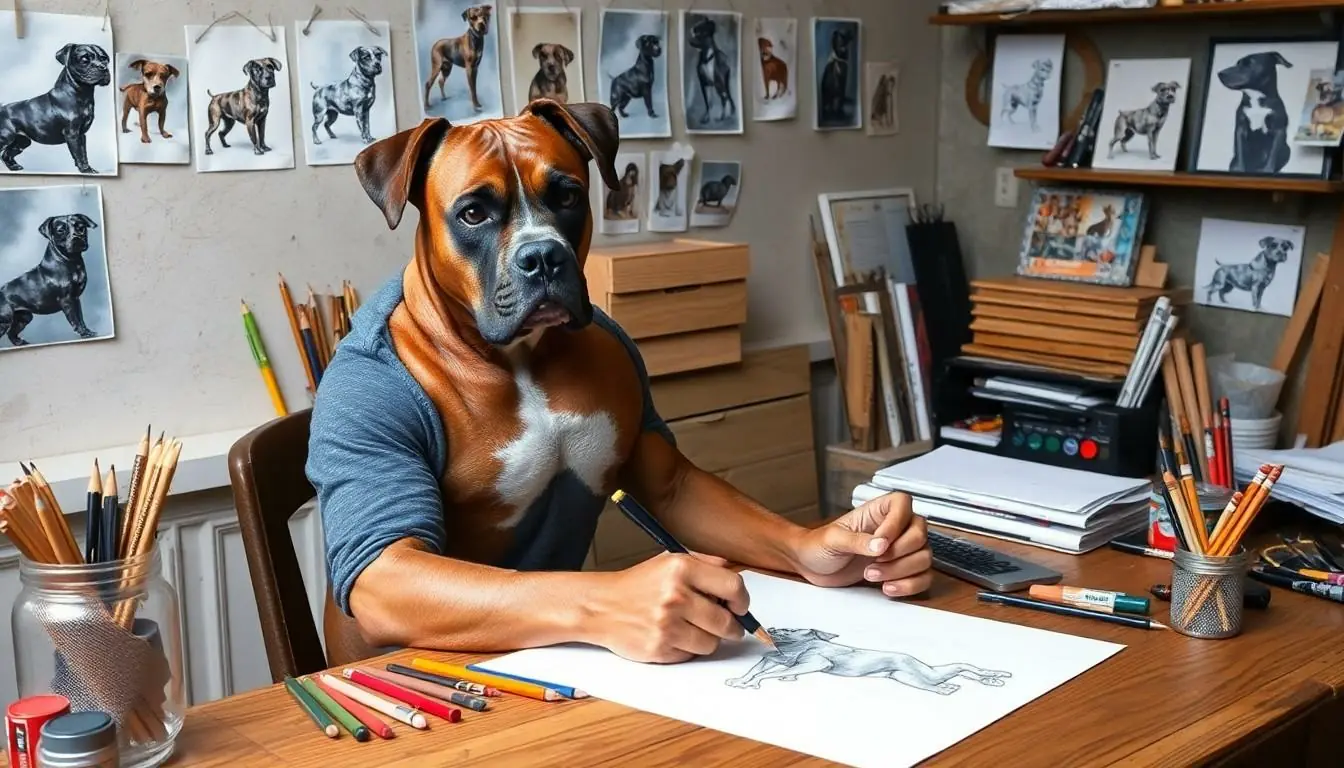Table of Contents
ToggleBoxer dogs are the clowns of the canine world, combining goofy charm with a muscular physique that’s hard to resist. When it comes to capturing their playful spirit on paper, a boxer dog drawing can turn a simple sketch into a heartwarming masterpiece. Whether you’re an aspiring artist or just someone who loves these lovable goofballs, putting pencil to paper can be a delightful way to express that adoration.
Overview Of Boxer Dog Drawing
Boxer dog drawing serves as an artistic expression that captures the breed’s distinctive features. Their well-defined muscles and expressive faces make them a captivating subject for artists. Artists often find joy in conveying the playful and goofy essence that boxer dogs embody.
Various techniques can enhance the drawing process. Using pencil allows for precise detailing, while charcoal can create bold, dramatic effects. Watercolor techniques provide a soft, vibrant look for those looking to experiment. Each method offers unique results, showcasing the breed’s charm in different ways.
Artists may choose reference photos to guide their work. High-quality images reveal details like the boxer’s expressive eyes, short coat, and sturdy build. Observing these elements aids in creating realistic representations.
Drawing tools play a significant role in the outcome. Graphite pencils of varying hardness can produce different line qualities. Fine liners help define edges, while blending tools create smooth transitions. The choice of paper can also affect texture and overall feel.
Understanding the anatomy of the boxer dog enriches the drawing experience. Familiarity with their body structure allows for accurate proportions. Recognizing how their muscles shape movement gives an animated quality to drawings.
Art communities often provide valuable feedback on boxer dog drawings. Sharing work online can help aspiring artists connect with others who share similar interests. Utilizing social media platforms allows for the exchange of tips and inspiration, enhancing one’s drawing journey.
Ultimately, boxer dog drawing can be fulfilling. Each sketch offers a glimpse into the spirit of this beloved breed. The process invites both creativity and appreciation for the unique characteristics that make boxer dogs special.
Techniques For Drawing Boxer Dogs

Drawing boxer dogs requires specific techniques that effectively capture their unique features and personality. Artists can choose between various methods that each offer distinct opportunities for expression.
Pencil Drawing Techniques
Pencil drawing is a versatile technique ideal for capturing the fine details of a boxer’s structure. Start by establishing the basic shapes and proportions with light strokes. Gradually build up the muscle definition by layering darker values and adding texture. Keep consistent pressure to create depth and shadows, ensuring the drawing reflects the boxer’s strong physique. Incorporating careful hatching can lend realism to features like their expressive eyes and defined muzzle. Observing reference photos helps artists capture intricate details, such as the unique wrinkles on their forehead. Artists can also practice blending techniques to soften transitions between light and shadow, enhancing the natural look.
Digital Drawing Techniques
Digital drawing offers a modern approach to illustrating boxer dogs. Utilizing software tools, artists can experiment with brushes that mimic traditional textures, from pencil to watercolor effects. Start with a digital sketch to outline the boxer’s proportions and major features accurately. Layers play a crucial role, allowing artists to separate details and work on elements like fur and shadow independently. Using different brush settings can aid in creating texture variations that bring the drawing to life. Artists often benefit from employing color palettes that reflect the boxer’s coat, capturing the essence of their playful personality. Taking advantage of undo options encourages experimentation, enabling quick adjustments to achieve desired results.
Popular Styles For Boxer Dog Drawings
Boxer dog drawings can showcase distinctive styles, highlighting the breed’s unique traits. Two popular approaches include realistic portraits and cartoonish renderings.
Realistic Portraits
Realistic portraits capture the essence of boxer dogs with lifelike details. Artists focus on accurate anatomy, including muscular structure and facial expressions. High-quality reference photos assist in depicting the boxer’s shiny coat and soulful eyes. Various mediums, such as pencil or charcoal, enhance the depth and texture of the artwork. Attention to light and shadow creates a three-dimensional effect, making the portrait feel vibrant. This style appeals to those who admire precision and detail in animal art.
Cartoonish Renderings
Cartoonish renderings offer a playful take on boxer dogs. This style exaggerates features, often highlighting large heads and expressive eyes, creating a whimsical feel. Bold colors and simplified shapes capture the lively spirit of the breed. Many artists use digital tools to experiment with various designs and layouts elegantly. This approach encourages creativity and allows artists to convey the fun personality of boxer dogs in a lighthearted manner. Cartoonish designs are perfect for children’s books or animated projects, bringing joy to viewers.
Common Mistakes To Avoid
Skipping reference photos leads to inaccurate details that weaken the overall drawing. Without these guides, capturing the distinct features of boxer dogs becomes challenging. Failing to understand the breed’s anatomy also results in disproportionate drawings. Attention to the boxer’s muscle structure ensures the artwork maintains realism.
Neglecting shading techniques can create flat images lacking depth. Applying appropriate hatching techniques adds dimension and realism to the artwork. Overcomplicating the drawing process by using too many techniques may confuse the desired style. Simplifying one’s approach allows for clearer artistic expression and better results.
Using low-quality materials can also hinder the quality of the drawing. High-quality paper and tools enhance the ability to showcase detail and texture. Not seeking feedback may limit growth as an artist. Engaging with art communities or peers provides valuable insights and fresh perspectives.
Rushing through the initial sketch can result in a lack of necessary foundational shapes. Taking the time to carefully outline the boxer’s form leads to more accurate proportions. Ignoring color choices during cartoonish interpretations might lead to dull representations. Utilizing vivid colors enhances the playful spirit captured in this style.
Lastly, neglecting practice stunts artistic progress. Regularly drawing boxer dogs builds confidence and improves skills. Commitment to continual practice ultimately enhances creativity and technical ability.
Tips For Improving Your Boxer Dog Drawing Skills
Utilize high-quality reference photos to capture accurate details of boxer dogs. These images provide insight into their expressive eyes and muscular build, crucial for creating lifelike drawings.
Focus on understanding the anatomy of boxer dogs. Knowledge of their skeletal and muscular structure ensures accurate proportions and adds character to the artwork.
Experiment with different drawing techniques. Pencil work allows for fine details, while digital methods offer flexibility for textures and layers. Each approach showcases the breed’s unique features effectively.
Incorporate shading techniques to add depth and dimension. Proper shading techniques help bring out the boxer’s form, making the dog appear more three-dimensional.
Practice sketching quickly to improve confidence. Quick gestures enhance familiarity with the boxer’s shapes and gestures, leading to more fluid drawings over time.
Attend local art classes or workshops. Interaction with fellow artists promotes skill development and inspires new ideas. Sharing experiences enriches the learning process.
Engage with online art communities for feedback. Constructive criticism from peers can help identify areas for improvement and encourage experimentation with styles.
Incorporate various styles into practice. Trying realistic and cartoonish interpretations provides versatility and aids in discovering personal artistic preferences. Over time, this exploration leads to a well-rounded skill set.
Regularly set aside time for drawing boxer dogs. Consistent practice allows for gradual improvement and strengthens artistic techniques.
Capturing the essence of boxer dogs through drawing is a fulfilling journey for artists and dog enthusiasts alike. Whether opting for realistic portraits or playful cartoon styles, each approach brings out the breed’s unique personality. By focusing on anatomy and utilizing quality materials, artists can create stunning representations that resonate with viewers.
Engaging with art communities and practicing regularly not only hones skills but also fosters a deeper connection to the subject. As artists explore various techniques and styles, they’ll find that the process of drawing boxer dogs is as rewarding as the final artwork itself. Embracing this creative endeavor allows for a celebration of the joy and charm these beloved dogs bring into our lives.




